What is Glide used for? Top Glide use cases across industries
12 min
read
Explore how Glide's no-code platform empowers businesses. Discover use cases, benefits, and real-world examples to see if Glide is the right fit for you.

Glide is a no-code platform that allows you to turn all your existing data – spreadsheets, databases, you name it – into powerful mobile and web applications. The best thing? You can avoid the long and costly process of traditional software development.
Many companies have turned to Glide to solve complex challenges, optimize workflows, and deliver exceptional customer experiences. And that's what we will explore in this article: how businesses across industries use Glide to create impactful applications that solve real-world problems.
Key features of Glide
Glide's no-code platform is packed with powerful features that make it an ideal choice for businesses seeking to develop custom applications across various use cases. Here are some of the key features that contribute to Glide's versatility and effectiveness:
Data integration
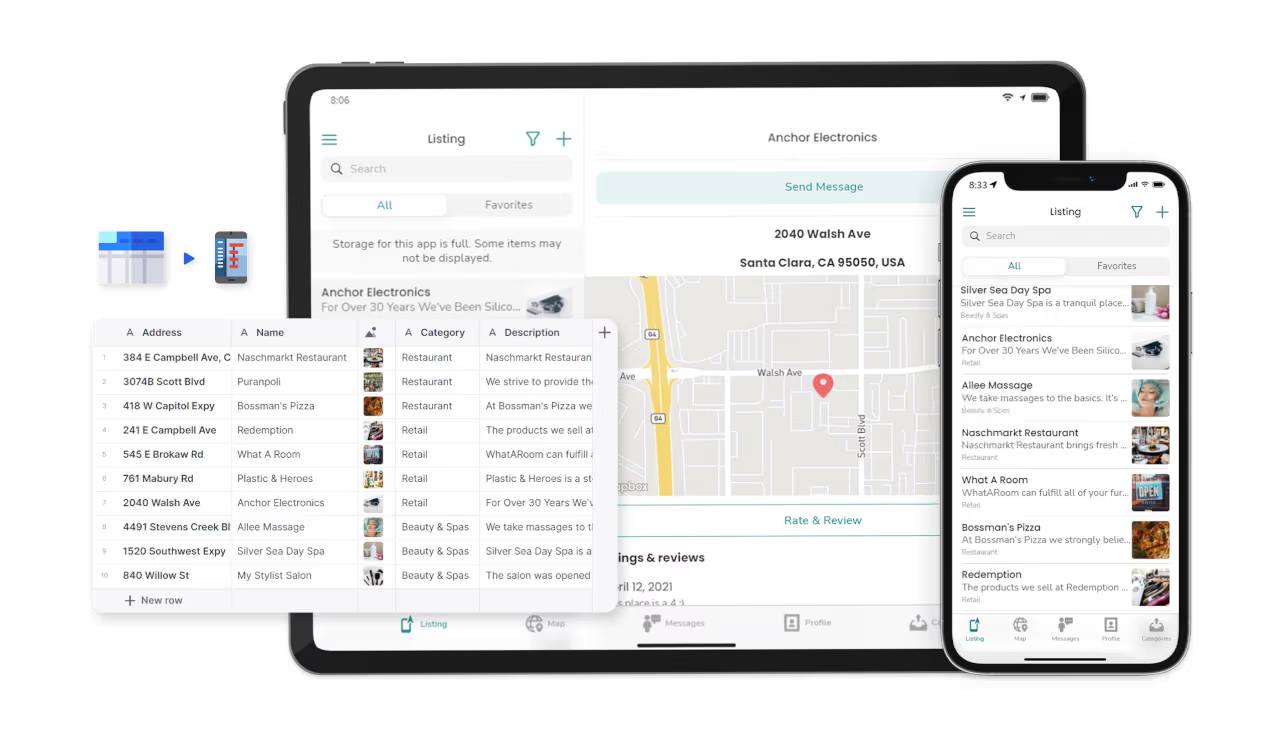
Glide integrates with all kinds of data sources, including spreadsheets, databases, and cloud storage platforms like Google Sheets, Airtable, and Notion. Businesses can use their existing data to build data-driven applications quickly. Many business processes rely on valuable data trapped in spreadsheets and databases. This information, if readily accessible and transformed into actionable insights, can help all kinds of operations: real-time inventory levels, sync customer information, better access to project management data, etc.
Customization capabilities
While Glide provides a wide range of pre-built components and templates, it also offers extensive customization options. Businesses can tailor the user interface, branding, and functionality of their mobile apps to align with their unique requirements and brand identity. Custom layouts, color schemes, advanced logic, and workflow automation, are some of the things you can customize with Glide to create a personalized app.
Built-in security measures
Security is a critical consideration when developing mobile applications, especially if you have to handle sensitive data. Glide incorporates robust measures such as user authentication, role-based access control, and data encryption. You’ll define who can manage, view, and edit your apps with detailed permissions for different user groups.
Glide works with open-source security tools and has intrusion detection systems on their infrastructure. They also run automated vulnerability scans, independent penetration tests, and regular security audits.
Glide holds a SOC 2 Type 1 Certification, an independent verification demonstrating they've established strong internal controls over systems and processes relevant to security, data availability, processing integrity, confidentiality, and privacy. Furthermore, they implement appropriate technical and security processes to ensure compliance with the General Data Protection Regulation (GDPR). This European regulation protects the privacy of individuals within the EU and sets high standards for data handling.
Cross-platform compatibility
Glide's applications are designed to work across iOS, Android, and the web, without having to dedicate separate development efforts for each platform. It’s ok if your employees, customers, or stakeholders use different devices because Glide's apps will provide a consistent and optimized experience through all of them.
Glide Tables and Glide Big Tables
In addition to connecting to your existing data sources, Glide also offers native database solutions. Glide Tables are the platform's built-in data storage option, capable of handling up to 25,000 rows of data. However, for businesses with more significant data needs, they offer Glide Big Tables, an enterprise-grade solution.
Glide Big Tables are powerful databases hosted directly within the Glide platform, capable of supporting up to 10 million rows of data. They offer advanced features such as charts, rollups, and full-text search, that enable businesses to visualize and make sense of massive amounts of data, such as inventory, sales, orders, and more.
Scalability and performance
Glide's architecture is built with scalability in mind, that’s why it’s suitable for businesses of all sizes, from startups to enterprises. As your business grows and your mobile app requirements evolve, Glide will keep performing at the highest level.
Glide achieves this scalability through a combination of efficient data storage and retrieval mechanisms, optimized query processing, and robust caching strategies. That’s why Glide can deliver consistent performance even under heavy loads.
One of the best things about Glide (and no-code development in general) is the flexibility it provides. You can roll out new features, modify existing ones, and scale your infrastructure accordingly. You can start small and keep on building, your app will remain competitive and meet the demands of your growing user base. Plus, Glide's version control feature allows you to track changes, revert to previous versions if needed, and ensure a smooth development process.
Automations and third-party integrations
Your Glide app is powerful on its own, but when you include automation and integrations, it truly jumps to the next level.
How does it work?
- Conditional logic: Define specific conditions within your app that trigger pre-defined actions. These conditions can be based on user interactions, like submitting a form or clicking a button, or data changes within your app, such as a new row being added or a status update.
- Actions: Set up the specific actions you want your app to perform when the defined conditions are met. This could be sending an email notification, updating data in another part of your app, or even triggering actions in external services.
Glide's most popular integrations include services like Zapier, Make, Google Analytics, Stripe, and many more. Let's see an example of automation and integrations working together:
Condition: When a user submits a lead capture form on your app.
Action: Automatically update the lead status in your Glide app to "New Lead."
Integration: Trigger a Zapier workflow that sends an email notification to your sales team with the lead details.
Related: Glide apps: A complete guide to Glide app development
Use cases: a detailed exploration
Business automation
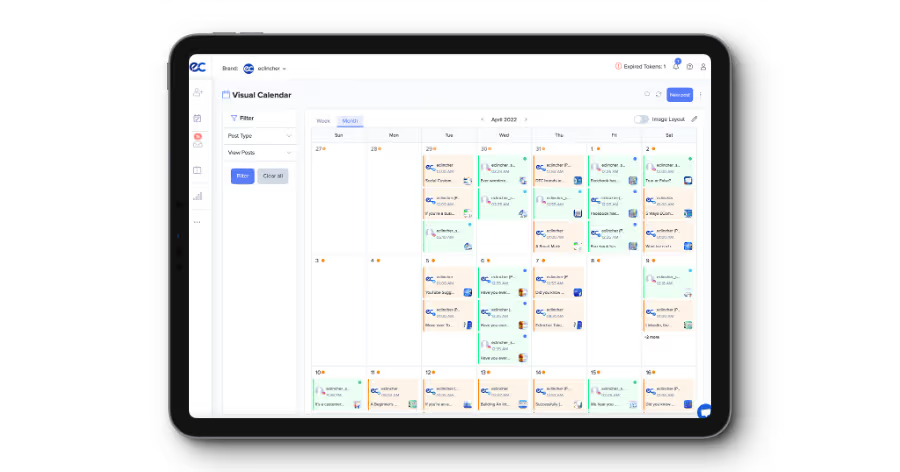
Challenges: Businesses often struggle with repetitive manual tasks. The problem is that they take valuable time away from employees who could focus on other, more important, tasks. There are also complex workflows across different departments that can lead to delays and errors.
Glide's solution: Define triggers within your Glide app based on user interactions or data changes. These triggers initiate pre-defined actions, automating repetitive processes.
Example: A marketing team can build a Glide app to automate campaign approvals. When a campaign is submitted, Glide can automatically notify relevant team members for review and trigger notifications based on approval status.
Benefits:
- Focus your team's energy on strategic tasks instead of repetitive chores.
- Eliminate human error.
- Minimize delays and bottlenecks on workflows.
- Automate communication and task handoffs between departments.
Logistics and transport

Challenges: Repetitive tasks like data entry, route planning, and shipment tracking are often handled manually, leading to errors and delays. Traditional methods lack real-time visibility into inventory levels, vehicle locations, and shipment status. Paper-based documentation slows down processes, increases the risk of errors, and makes data retrieval difficult.
Relying on spreadsheets for delivery route planning often leads to inefficiencies. Studies show that using an Excel route planner is only practical for very small teams. Glide apps, on the other hand, let you automate route assignments, reduce delays, and manage logistics seamlessly.
Glide's solution: A Glide app can be a central hub for drivers, dispatchers, and warehouse personnel. Real-time data visualization helps with insights into inventory levels, vehicle locations, and shipment status. You can upload documents within the app for easy access, retrieval, and version control.
Example: Known Logistics struggled with a clunky shipment tracking process. They held all the necessary information on their Azure database, but it lacked a user-friendly interface. We built an interactive customer portal integrated with Azure, using Glide and Make. Now customers can view dynamic maps displaying the exact location and route of their shipments.
The app allows customers to track delivery dates, view arrival ports, and receive updates on changes or delays. Given they can access information directly, the support inquiries were reduced, and the staff gained back the time they spent resolving tracking-related issues.
Benefits:
- Streamlined workflows save time and money.
- Real-time data and automated workflows make operations more efficient
- Complete transparency into your logistics network, for better decision-making and proactive problem-solving.
- Faster deliveries, improved communication, and reduced errors lead to happier customers.
Related: How to use Glide for an inventory app
Data visualization and management
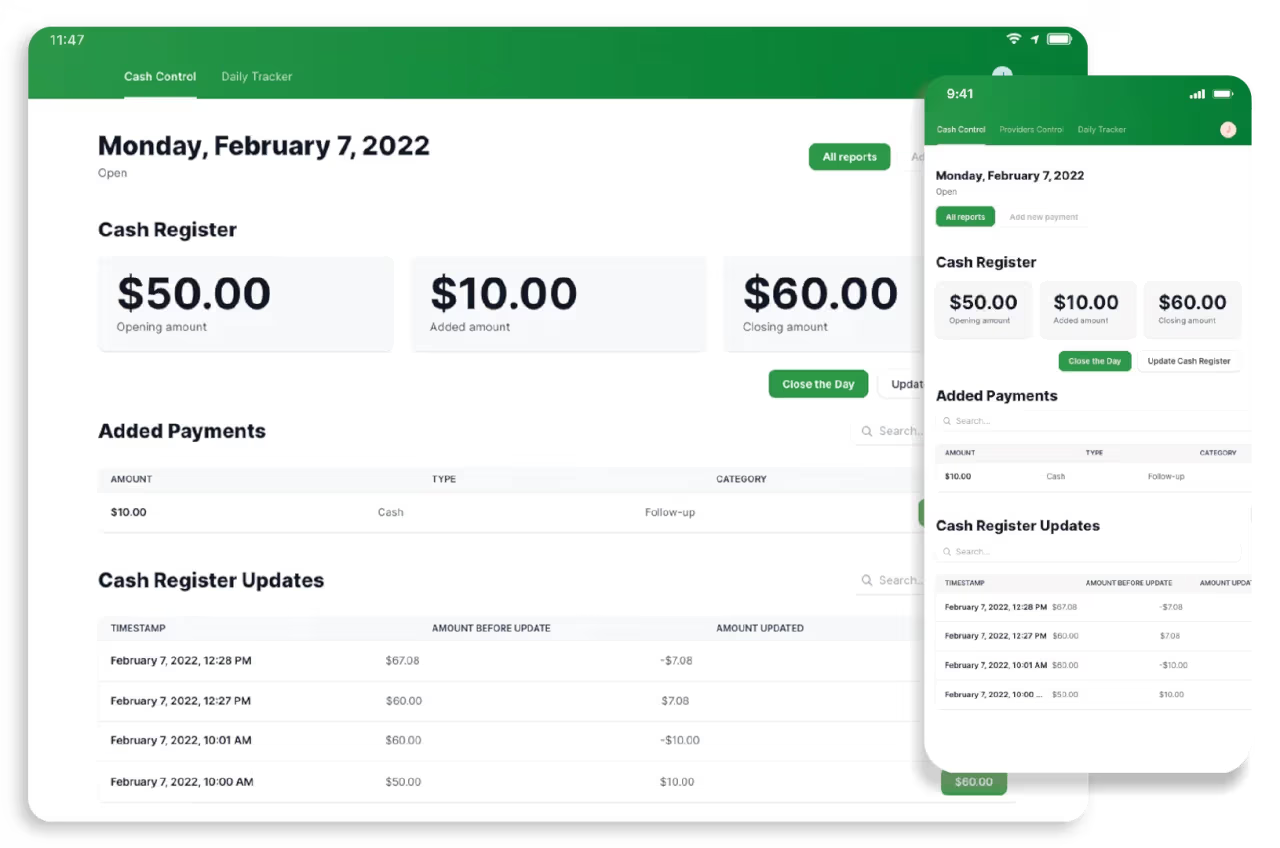
Challenges: Businesses today are bombarded with data. The challenge lies in making sense of it all. Traditional methods can be complex and inaccessible, hindering valuable insights that could drive better decision-making.
Glide's solution: Transforming all your data into a strategic asset. Here's how:
- Glide integrates with your existing spreadsheets and databases, no need for complex data migrations.
- Glide offers built-in data visualization tools like charts, rollups, and full-text search. Move beyond raw numbers. You can explore large datasets, identify trends, and uncover hidden patterns within your data.
Example: A sales team can build an app that displays sales performance by region. Charts and rollups provide a clear visual representation of sales data for them to identify top-performing regions and adjust strategies accordingly.
Benefits:
- Clear and actionable insights from your data to guide strategic business decisions.
- Communicate complex data insights to stakeholders in a clear and easily digestible format.
- Data-driven discussions and collaboration across departments.
- Easier data exploration, for anyone in the organization to discover valuable insights.
Customer relationships
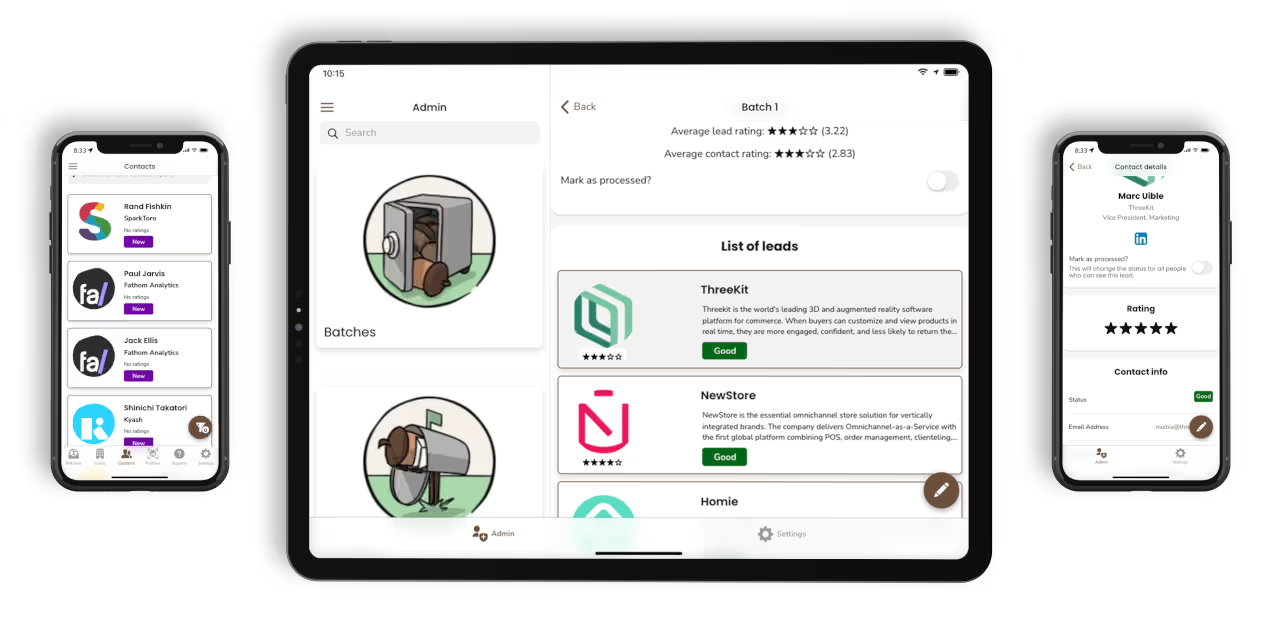
Challenges: Building and maintaining strong customer relationships can be challenging, especially for businesses juggling multiple communication channels and scattered customer data. There are many pain points we can mention: difficulties tracking communication history, lack of centralized customer data, and missed opportunities for personalization. Also, manual processes for tasks like lead management, loyalty programs, and customer support requests slow down operations.
Glide's solution: With a Glide app you can store and manage customer information (purchase history, preferences) and gain valuable insights to personalize the customer experience. Use Glide + Make to trigger based on specific events. For example, automatically send a welcome email when a new lead signs up, trigger a loyalty point notification after a purchase or create a customer support ticket upon receiving a negative social media review. Keep customers and staff informed with real-time notifications.
Example: The team behind IntroCRM needed a better system to handle their growing business, so we built a custom app using Glide. First of all, the app is a centralized hub, a single source of truth for all lead and customer information. We built a feature that allows them to upload their leads in batches, instead of wasting time in manual data entry. IntroCRM can easily monitor progress and analyze data, and that's crucial because, of course, not all leads are equal. The app allows the team to rate leads based on their potential, so they can focus on the most promising opportunities.
Benefits:
- Build stronger relationships through personalized communication and targeted marketing campaigns.
- Automate tasks, manage data efficiently and free up staff time for strategic initiatives.
- Gain valuable insights from customer data to inform marketing strategies, product development, and customer service.
Educational tools and eLearning
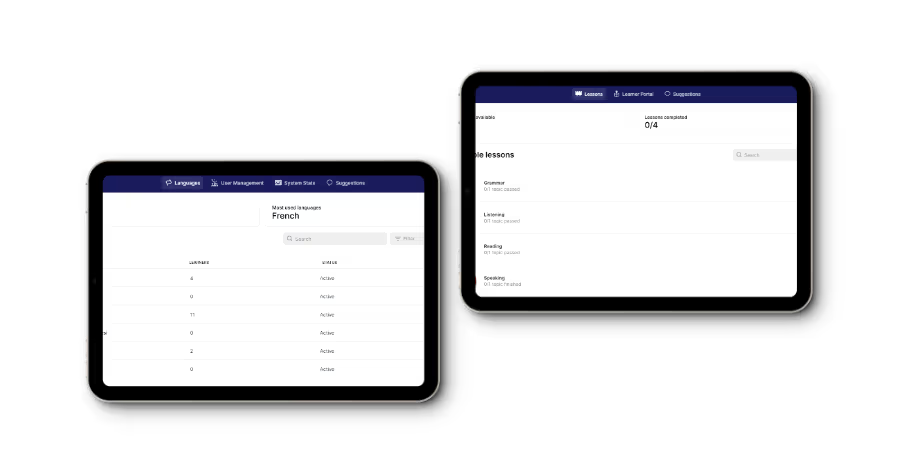
Challenges: Traditional learning materials can be static and lack engagement. Educators struggle with limited tools to create interactive and personalized learning experiences. Also, providing immediate feedback and personalized guidance can be time-consuming for educators with large classes.
Glide's solution: You can build applications with interactive elements like quizzes, flashcards, and polls. Students can actively engage with the material, and have a platform to exchange feedback with the teachers. Glide+AI unlocks even more possibilities, for example, you can use AI text analysis features to automate the grading of short answer questions and give immediate feedback to students.
Example: Language Keeper, an app we built using Glide+AI is a great example of how it can be used to create engaging learning tools. Nibras Clapp came to us because she wanted an app to help military students retain the languages they learn annually.
With Glide, we were able to build an app that includes:
- Bite-sized lessons: Students learn grammar, reading, listening, and speaking on the go.
- AI-powered practice: Personalized feedback and practice conversations with an AI chatbot.
- Track your progress: Assessments at the end of each level with grading and feedback.
The results were impressive too, students completed 70% more lessons compared to traditional methods! You can read more about this case study here.
Benefits:
- Personalized learning with AI-powered feedback, adaptive learning paths, and AI tutors.
- Interactive elements and immediate feedback keep students motivated and actively involved in the learning process.
- Glide apps can be accessed on various devices. Students can take lessons anytime, anywhere.
- Related: Glide AI features in action
- Related: 6 Benefits to building AI powered apps with Glide
Real estate and property management

Challenges: Real estate agents and property managers handle many time-consuming tasks: manual data entry for listings, countless emails back and forth with tenants, and phone calls for maintenance issues. Relying on multiple channels like email, phone calls, and text messages creates confusion and can lead to missed messages or delays.
Glide’s solution: Many Glide features can come into play. Integrating with existing listing databases or spreadsheets to create mobile-friendly listing apps with up-to-date property details. Automated workflows for processing rental applications, maintenance requests, and lease renewals. Real-time updates and notifications. Integration with third-party services like online payment gateways.
Example: User-friendly listing apps where you can showcase properties with photos and detailed descriptions, that are easy to update. A Glide app can be the perfect communication platform between managers and tenants. Tenants can submit maintenance requests, track rent payments, and access important documents.
Benefits:
- Improved satisfaction for tenants.
- Centralized communication and data within the app.
- Better visibility into property listings, tenant communications, and maintenance requests for better overall management.
Inventory management
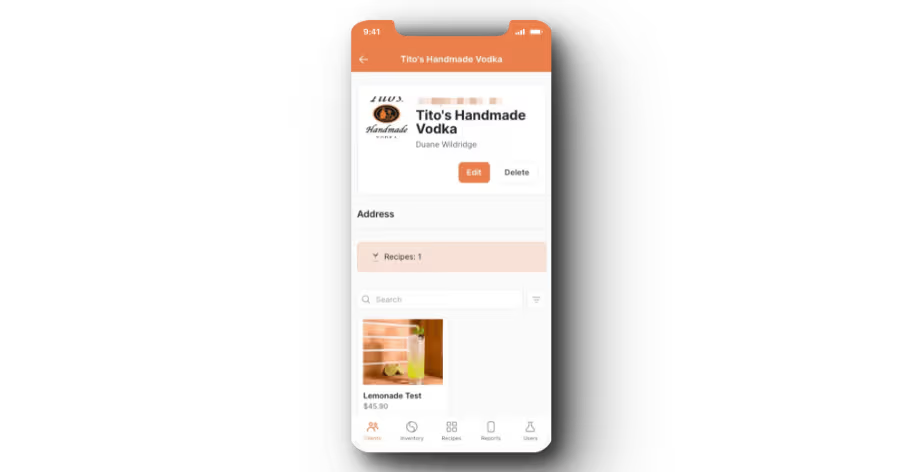
Challenges: Many problems come with using inappropriate tools for inventory management. Inconsistent tracking, due to manual work across spreadsheets and software. Difficulty maintaining optimal stock levels, and quick updates that lead to excess inventory costs or stockouts that frustrate customers. Manual processes for picking, packing, and shipping slow down order fulfillment and impact customer satisfaction.
Glide’s solution: Glide is perfect for building a custom inventory management solution that can include:
- Data integration with existing listing databases or spreadsheets to create mobile-friendly listing apps with up-to-date property details.
- Instant insights into stock levels with automatic updates.
- Workflows for efficient picking, packing, and shipping processes.
Example: The team at StraightUp Collective relied on Excel spreadsheets for inventory management. It's very common for businesses to use spreadsheets at the beginning. Still, they all face the same problems down the line: Manual data entry and constant updates become a burden for staff, there are many typos and inconsistencies, lack of real-time data, and more. We built a user-friendly inventory management tool using Glide, specifically designed for Straight Up Collective's needs.
Their custom Glide app makes all of their data much more accessible. It’s a complete platform that includes images of each drink, plus appropriate glassware and preparation techniques for each recipe. Adding new ingredients automatically calculates the cost per ounce, without manual calculations and potential errors. And our favorite part, Glide generates reports for admins, with valuable insights into inventory levels and purchasing trends.
Benefits:
- Eliminate manual data entry and human error.
- Maintain optimal inventory levels to avoid overstocking and stockouts.
- Better warehouse processes and order fulfillment for faster deliveries.
- Enhanced inventory management leads to happier customers with fewer order fulfillment issues.
- Insights to make informed purchasing and inventory management decisions.
Related: +20 inspiring Glide app examples for 2024 (lowcode.agency)
Understanding the limitations of Glide
- Storage and data management: Businesses with strict data control and ownership requirements may face limitations with Glide's data storage and management models. If your organization has specific data governance policies or regulatory requirements, you may need to evaluate Glide's compliance and data management capabilities thoroughly.
- Limited offline functionality: Glide apps primarily function online. While some basic offline functionality can be achieved with workarounds, complex offline data editing or synchronization might be challenging.
- Vendor lock-in: Since Glide is a hosted platform, businesses are somewhat reliant on their infrastructure and service availability. While Glide prioritizes uptime and security, there's always a degree of vendor lock-in compared to self-hosted solutions.
- Custom code: Glide supports JavaScript for data processing purposes, and there’s no baked-in support for other coding languages. Experienced developers can explore more options with the Experimental Code column.
Related: Glide advantages and disadvantages
Are you interested in a similar solution for your business? We can help you. Contact us for a free consultation!
Created on
April 28, 2024
. Last updated on
August 29, 2025
.

FAQs
What can you build with Glide?
How does Glide work?
Which companies use Glide?
Who owns Glide apps?








%20(Custom).avif)








